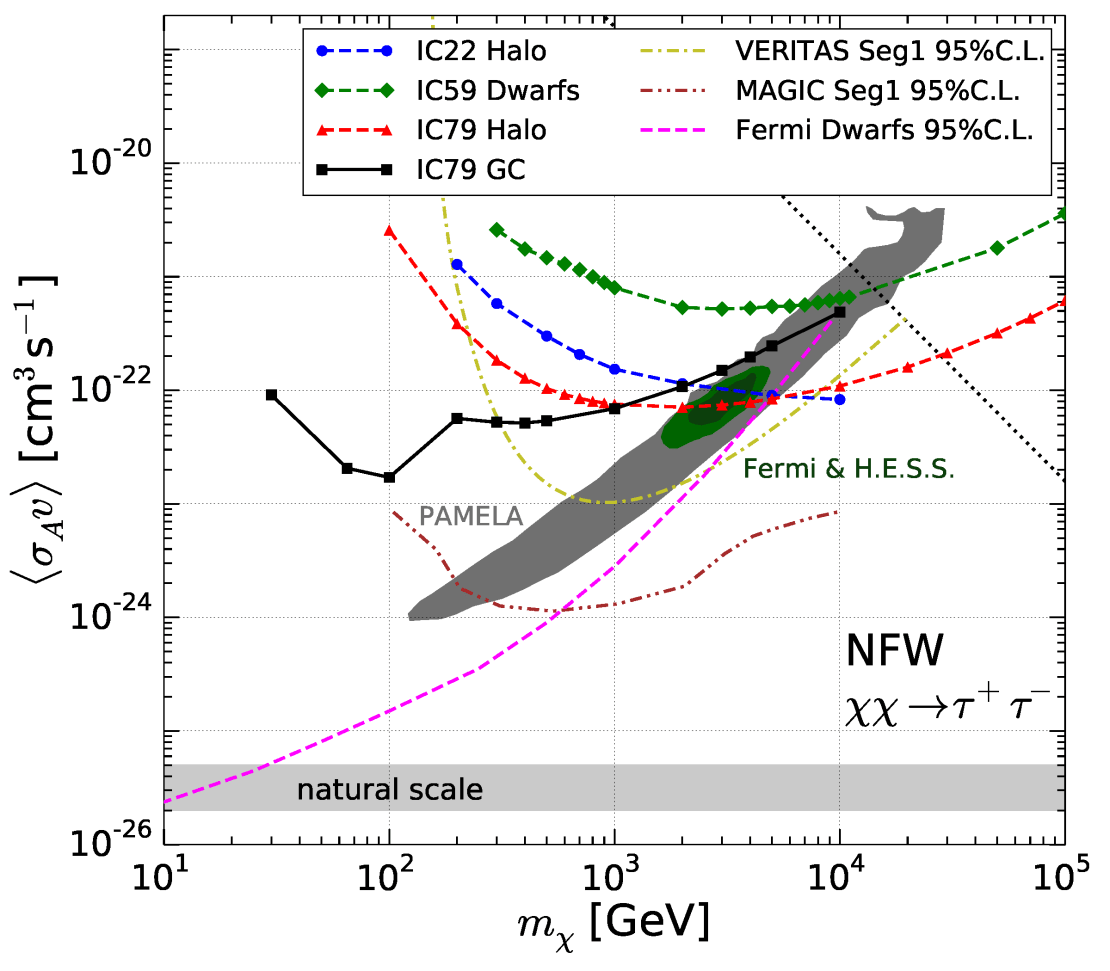A few months ago, IceCube published a search for dark matter in the galactic halo. In that study, researchers were looking for an excess of muon neutrinos that would have been created by the self-annihilation of dark matter particles in the Northern Hemisphere, where the galactic halo is partially visible from the Pole. The search in this direction is especially suitable for IceCube since the Earth filters the enormous background of atmospheric muons.
In a new analysis by the IceCube Collaboration, a search for dark matter annihilation at the Galactic Center is presented using data from the same data taking period. The highest density of dark matter in the Milky Way is anticipated to concentrate in its center. Dark-matter self-annihilation should then produce a flux of muon neutrinos and other particles that peaks in the direction of this region, which is seen in the Southern Hemisphere by IceCube. The search did not find a neutrino excess, and the researchers have set new limits on the dark-matter self-annihilation cross section. These results have been submitted today to European Physical Journal C.

The search targeted dark-matter masses from 30 GeV to 10 TeV. In this energy scale, theoretical models postulate WIMPs, or weakly interacting massive particles, as the most favorable candidates of dark matter. Neutralinos are the lightest of these and they star in dark-matter searches with different experiments.
Due to the location of the Milky Way center, the search for dark-matter induced neutrinos from this region means searching for an extended source in the Southern Hemisphere, always 29 degrees above the horizon. “Selecting neutrinos coming from this side of the sky is much more challenging for IceCube since atmospheric muons from the same direction are a million times more abundant,” says Samuel Flis, an Icecube researcher at Stockholm University and one of the corresponding authors of this paper. Therefore, only neutrinos that interact within the detector were selected. “By excluding interactions that begin outside the detector or within the veto region, the large background of penetrating atmospheric muons is rejected,” adds Flis.
For a low-mass region, i.e., up to 100 GeV, events were selected using the infill array DeepCore and the surrounding parts of IceCube as veto. This denser subdetector of IceCube was designed to lower the energy threshold, enabling precise measurements of the neutrino-oscillation parameters, but it also extended searches for dark matter. For the high-energy region, the outer IceCube digital optical modules are used as a veto, keeping the rest of the detector as fiducial volume.
Over 4,000 events were found in the low-energy region and almost 37,000 in the high-energy region, which are compatible with the background-only hypothesis. IceCube researchers have set upper limits to neutralino self-annihilation cross section. “The measurements presented in this paper, in particular the upper limit for the annihilation into neutrinos, represent conservative upper bounds of the total cross section,” explains Martin Wolf, a graduate student at Stockholm University and also corresponding author of this paper. “These limits complement gamma-ray detection channels, and they will improve with future IceCube searches” adds Wolf.
“The Galactic Center is a particularly intriguing region following the gamma-ray excess measured e.g. by Fermi, which seems to be compatible with dark matter annihilations in the NFW halo model,” further explains Martin Bissok, the third corresponding author of the paper and a graduate student at RWTH Aachen. Those results sparked a remarkable interest in the dark-matter community. IceCube searches using neutrinos, as Bissoks points out, “benefit from the lack of (known) astrophysical sources as background.”
+ Info “Search for Dark Matter Annihilation in the Galactic Center with IceCube-79,” IceCube Collaboration: M.G. Aartsen et al. European Physical Journal C75 (2015) 492, arxiv.org/abs/1505.07259 link.springer.com